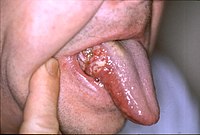
Photo from wikipedia
Objective To explore risk factors for dry mouth and examine the clinical utility of the heart rate variability (HRV) test in the prediction of dry mouth. Methods Every outpatient, who… Click to show full abstract
Objective To explore risk factors for dry mouth and examine the clinical utility of the heart rate variability (HRV) test in the prediction of dry mouth. Methods Every outpatient, who underwent tests for both unstimulated salivary flow and HRV, was retrospectively reviewed. After excluding seven subjects, the demographics and clinical factors in 70 total patients were collected. Based on objective salivary flow rates, patients were classified into normal (≥0.2 mL/min) or hyposalivation groups (<0.2 mL/min), and inter-group comparisons were performed with a two-tailed statistical significance of 0.05. Results Patients with subjective dry mouth were significantly more likely to show hyposalivation. Advanced age, female sex, and current use of psychotropic medications were identified as risk factors for dry mouth. However, dry mouth was not associated with any HRV parameters. Conclusion HRV test did not demonstrate a clinical utility in predicting dry mouth. Because subjective dry mouth is significantly associated with objective hyposalivation, a simple probing question would be useful for early recognition of dry mouth. Clinical attention is required for patients meeting criteria of older age, female, and/or using psychotropic prescriptions. Prompt management of hyposalivation may improve quality of life and clinical outcome by enhanced treatment adherence.
Journal Title: Psychiatry Investigation
Year Published: 2023
Link to full text (if available)
Share on Social Media: Sign Up to like & get
recommendations!